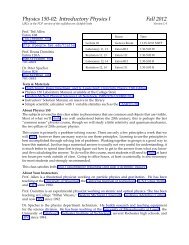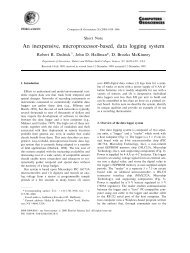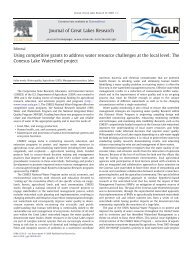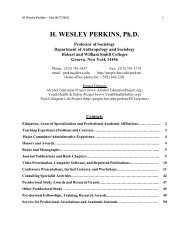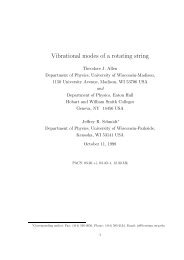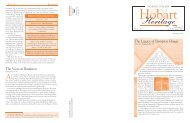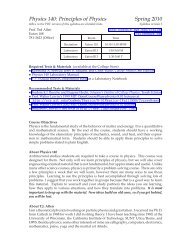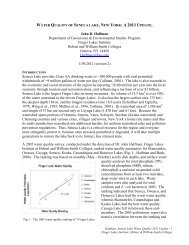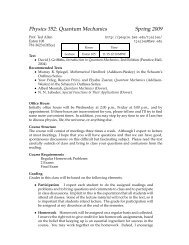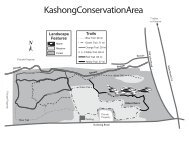Geology of New Zealand Field Trip Guidebook - ResearchGate
Geology of New Zealand Field Trip Guidebook - ResearchGate
Geology of New Zealand Field Trip Guidebook - ResearchGate
You also want an ePaper? Increase the reach of your titles
YUMPU automatically turns print PDFs into web optimized ePapers that Google loves.
In contrast, the Axial Tectonic Belt (Fig. 1) is by far <strong>New</strong> <strong>Zealand</strong>’s most active<br />
region. It extends across both islands, from Fiordland in the southwest through the Southern<br />
Alps, Marlborough, and the eastern half <strong>of</strong> the North Island. It includes the most important<br />
fault systems in <strong>New</strong> <strong>Zealand</strong>, particularly the Alpine Fault bounding the Southern Alps to<br />
the west, the Hope Fault in Marlborough, and the North Island Shear Belt (Aitken 1996).<br />
Because the collision between the Pacific Plate and the Australian Plate is oblique here, a<br />
tremendous amount <strong>of</strong> shear stress is generated along with compression. Thus, almost all <strong>of</strong><br />
the faults active in this region produce shear (strike slip motion) as well as compression<br />
(reverse motion). This combination <strong>of</strong> forces along this system can produce intense seismic<br />
activity. Movement along the Alpine fault averages 35 mm/year; it produces major quakes<br />
every 250-400 years with average movements <strong>of</strong> 8 m horizontally and 12 m vertically<br />
(Aitken 1996). Based on mapping <strong>of</strong> rocks on either side <strong>of</strong> the Alpine Fault, geologists<br />
estimate that it has moved 480 km in the last 20 Ma (McSaveney and Nathan 2007).<br />
Movement along the Marlborough fault system has a slightly lower rate <strong>of</strong> 15-25 mm/year.<br />
On the North Island, rates <strong>of</strong> movement are more difficult to measure because the fractured<br />
rocks are buried beneath a thick blanket <strong>of</strong> more recent volcanic debris. However,<br />
observations <strong>of</strong> the topography show that horizontal, rather than vertical, movement<br />
dominates here, owing to the angle <strong>of</strong> the plate collision.<br />
The Taupo Volcanic Zone (Fig. 1) is a region <strong>of</strong> crustal thinning caused by heating<br />
and extension associated with subduction under this region (Aitken 1996). Where continental<br />
crust generally averages about 35 km thick, the crust under the Taupo region is only about 15<br />
km thick. This reflects significant heat generated by the rapidly subducting Pacific Plate. As<br />
this heat rises through the crust, it causes the crust to expand, rise, thin and pull apart to a<br />
small degree. This, topped by the volcanoes themselves, produces the spectacular<br />
topography found in the Taupo Volcanic Zone.<br />
The Western North Island and Canterbury-Chathams Platform (Fig. 1) are<br />
relatively quiet compared to other regions. Fault movement in the Canterbury-Chathams<br />
region averages less than 1 mm/year (Aitken 1996), while few recently active faults are<br />
known from the Western North Island.<br />
Tectonic History<br />
The oldest rocks exposed in <strong>New</strong> <strong>Zealand</strong> today were formed on an ancient<br />
continental shelf adjacent to present-day Australia and Antarctica (McSaveney and Nathan<br />
2007). These rocks began their lives as sediments washed down from mainland Gondwana<br />
during the Cambrian through Devonian periods (refer to the geologic time scale at the end <strong>of</strong><br />
this guide for age dates). During the Late Devonian and Carboniferous, subduction<br />
developed to the east <strong>of</strong> the Gondwanan passive margin, compressing, metamorphosing, and<br />
folding these sediments into the near vertical orientations observed today (McSaveney and<br />
Nathan 2007). What started as clastic deposits are now schists and gneisses. In some places,<br />
metamorphosing temperatures grew so high that the ancestral sediments actually melted,<br />
recrystallizing as the granites and diorites exposed along the west coast <strong>of</strong> the South Island<br />
from Fiordland to Nelson. These rocks are hard and resist weathering and erosion, producing<br />
Fiordland’s spectacular steep-walled valleys.<br />
At about 200 Ma, subduction ceased and a passive margin redeveloped along the<br />
eastern coast <strong>of</strong> Gondwana (Fig. 2). Sediments once again began to stream <strong>of</strong>f the<br />
Gondwanan highlands, producing the Torlesse greywackes (dirty sandstones), which are<br />
thousands <strong>of</strong> meters thick and cover more than half <strong>of</strong> the <strong>New</strong> <strong>Zealand</strong> land mass<br />
(McSaveney and Nathan 2007). In most places, the sandstone alternates with darker<br />
mudstone, indicating that these were produced in a deep-water continental shelf and slope<br />
environment where submarine landslides producing turbidity currents deposited most <strong>of</strong> the<br />
12




